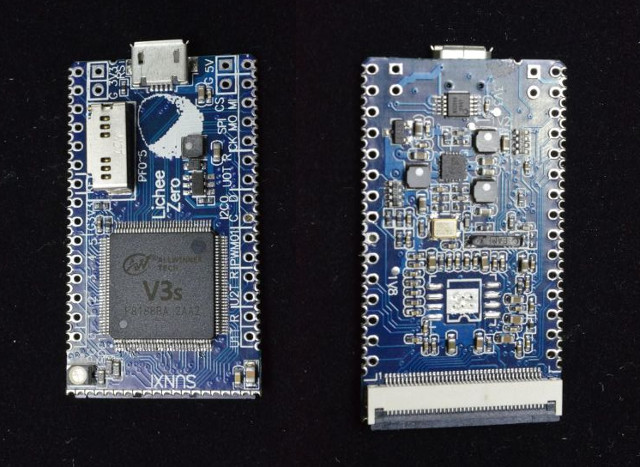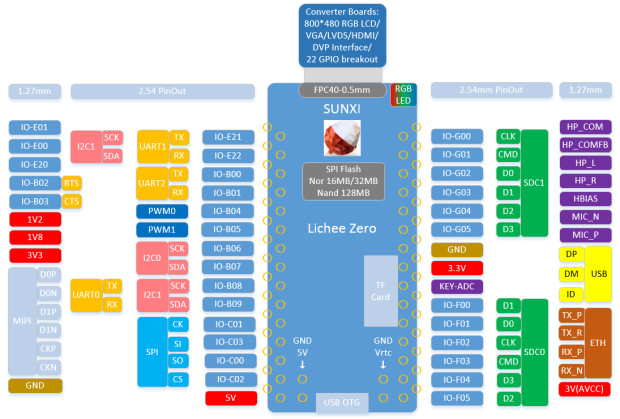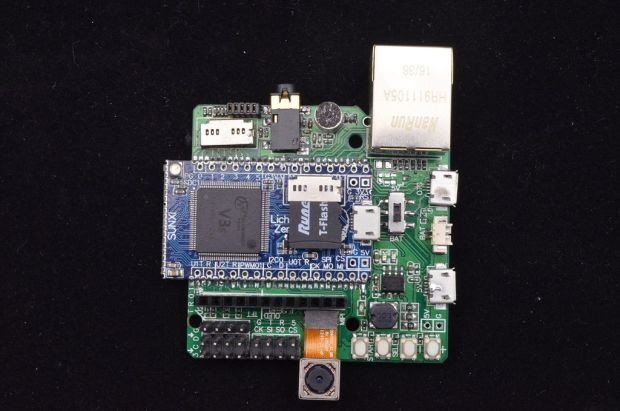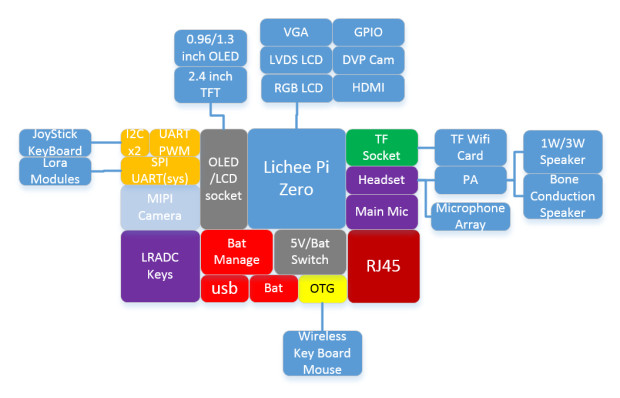We’ve already covered LicheePi One board powered by Allwinner A13 processor, but it was not for sale out of China, and the developers are now back with LicheePi Zero board/module, slightly bigger than an SD card, featuring Allwinner V3s processor, and offered for as low as $6, or $8 with WiFi via an Indiegogo campaign.

LicheePi Zero specifications:
- SoC – Allwinner V3s ARM Cortex A7 processor @ up to 1.2 GHz with an ARM Mali-400 GPU, 512Mbit (64MB) DDR2 on-chip
- Storage – micro SD card slot, SPI flash (not 100% clear if it will be populated when shipped to backers)
- Display – FPC40 RGB Connector with support for 800×480 RGB LCD
- Audio – Audio codec
- USB – micro USB OTG port
- Expansion
- 2x 15 headers with 2.54mm pitch, breadboard friendly with GPIOs, 2x UART, 1x SPI, 2x I2C,ADC, 1x PWM
- 2x 30 half-holes with 1.27mm pitch with OTG USBMIPI CSIEPHYRGB LCD, more GPIOs
- RGB connector can take add-on boards for GPIO, LVDS, HDMI, VGA, etc…
- Misc – RGB LED
- Power Supply – 5V via micro USB port, or 5V/GND header
- Dimensions – 44.6×25.5mm

Most development board come with SDK using older version of Linux, but LicheePi Zero supports the latest Linux 4.10 kernel, as well as buildroot, Debian, and Raspbian Jessie with Pixel (experimental). The source code and hardware documentation can be found on Github.
Another selling point of this tiny board is the number of add-boards, with a WiFi board that be either plugged into the micro SDcard slot, or soldered along some of the 2.54mm pitch header, several converter using the RGB interface for VGA, LVDS, HDMI, DVP camera) or even some extra GPIOs.
 The developer also provides a baseboard for LicheePi Zero module giving access to a 3.5mm audio jack, a built-in microphone, and Ethernet, as well as I/O ports for even more add-ons such as cameras, OLED or TFT displays, speakers, LoRa modules, and so on.
The developer also provides a baseboard for LicheePi Zero module giving access to a 3.5mm audio jack, a built-in microphone, and Ethernet, as well as I/O ports for even more add-ons such as cameras, OLED or TFT displays, speakers, LoRa modules, and so on.
The modularity and options of Lichee Pi Zero is well summarized in the diagram below.
 To get started easier, the developers also worked on some projects or bundles like a portable Linux handheld computer, a mini DIY laptop, VGA or HDMI computer bundles, “LoRa Netgate”, wireless speakers, etc… You can watch the demo of some of those, and more details about the board and modules in the video below.
To get started easier, the developers also worked on some projects or bundles like a portable Linux handheld computer, a mini DIY laptop, VGA or HDMI computer bundles, “LoRa Netgate”, wireless speakers, etc… You can watch the demo of some of those, and more details about the board and modules in the video below.
While LicheePi Zero and ZeroW models are respectively $6 and $8 per unit, you can’t buy one only at price, as the minimum order is two, so $12 for Zero, and $16 for ZeroW, except for the developer edition (shipped ASAP) that’s $12 for one ZeroW. ZeroW mini laptop DIY suit rewards with a LicheePi Zero, a micro SD wifi card, an OTG adapter, a 5″ 800×480 LCD, a wireless keyboard, a LiPo battery, and other accessories as shown at the start of the video above is just $39, while the LoRa Netgate suite with 2 A.I Thinker LoRa modules and a custom protocol (not LoRaWAN) goes for $40. There are many other rewards that you can checked in the Indiegogo page. Shipping is not included by only adds $5, and delivery is planned for May to June 2017 depending on perks. You can ask your question on on Indiegogo, as well as iLichee Forums.
Thanks to Freire for the tip.

Jean-Luc started CNX Software in 2010 as a part-time endeavor, before quitting his job as a software engineering manager, and starting to write daily news, and reviews full time later in 2011.
Support CNX Software! Donate via cryptocurrencies, become a Patron on Patreon, or purchase goods on Amazon or Aliexpress




